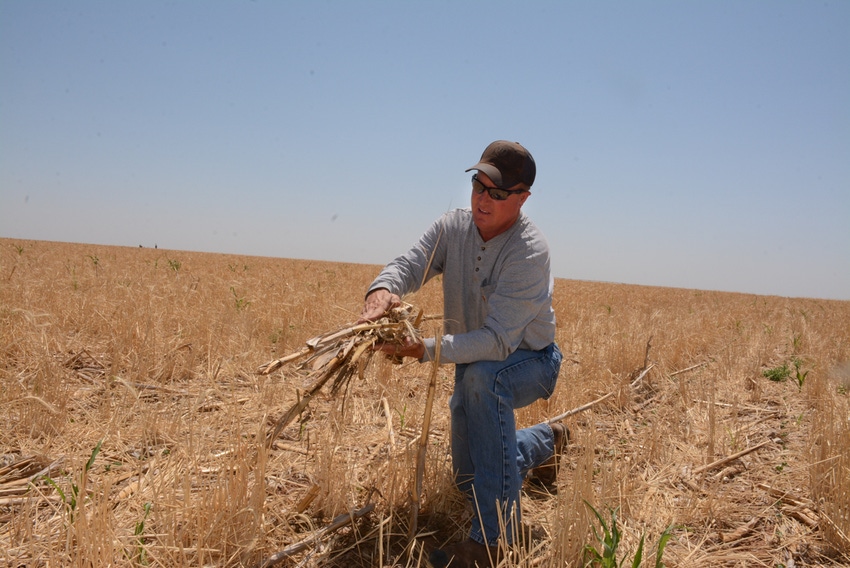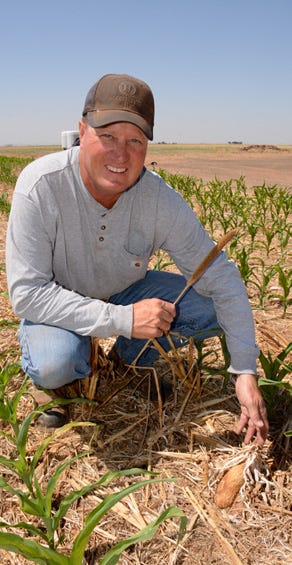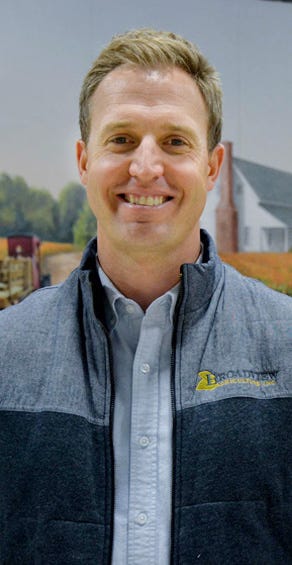
While blast furnace temperatures, coupled with a lack of significant moisture, continue to test the faith of Southwest farmers, the adverse conditions have only strengthened the belief of Texas farmer Kelly Kettner of the value of his no-till cover-cropping system.
“When you think about being in a drought, a lot of guys are worried about the use of cover crops, and if anything, drought this year has convinced me that cover crops are so important, even on dryland,” says Kettner. “I’ve never seen a cover crop cost me a crop — if anything I’ve seen it save me a crop when plowed ground lost one, mainly due to sand or moisture issues later on.”

Kelly Kettner, Parmer County, uses radishes in his cover crop system.
Knee-high rye saved his cotton during a recent hail storm. On one section, Kettner has two pivots next to each other. Both circles have a rye cover crop and both are planted to cotton. One of the circles has “excellent rye residue,” while the other rye field, due to delayed planting and lack of fall moisture, is kind of “light.” The excellent rye was up to Kettner’s knees, while the other, after he sprayed it, melted down, keeping the soil from blowing, but not what he would describe as “full cover.”
“The storm we had the other night had pea to marble-sized-hail, and I didn’t have to replant cotton on the field that had the real tall cover, but I did have to replant cotton on the one that didn’t, and that’s right across the turn-row.” Kettner says cotton survived a similar hail storm in 2003. “One year, I had cotton in some really tall rye stubble. There wasn’t a field of cotton within 10 miles of this field of that made it through the hail storm, but mine made it through and made like 2.5 bales to the acre.”
But no matter the cropping system, Kettner, like many growers on the South Plains, is struggling to get a crop up.
See Photo Gallery: No-till, cover crops protect young cotton from hail
“It’s like we skipped spring. We were cold and dry in April, and we went to super hot in May, with a lot of wind. It’s just been a battle to get a crop up, mainly with the dryland, but even the irrigated has been tough,” Kettner admits. “This year I’m planting the whole circle to cotton, watering half of it and then trucking the pivot back at 100 percent to where I started and watering it a second time to guarantee I have the seed in moisture so it will sprout and survive. Normally, after I get the first half done, I work on the second half — I’ve never had to do this before, but when it’s 5 percent humidity and 30 mph winds every day, it kind of forces our hand into that.”
Southeast of Parmer Coutny, no-till farmer Jeremy Brown, who farms in the sandy soils of Lamesa, Texas, echoes Kettner’s frustrations with cotton emergence this year.
“Emergence is slower,” says Brown. “I don’t know if it’s no-till stuff, but the soil temperature is a little bit cooler — it’s just really weird. I have one farm where we had some center rows where modules had been stacked. So, we had these 16 rows right in the middle that didn’t have any cover, and the cotton I planted there popped right out of the ground, and that’s irrigated land. But the no-till stuff is taking a little longer.”
Brown says it’s also a challenge to plant through his cover crop residue, something he deals with every year. “You have to manage it a little differently,” Brown says. “Trying to get through that and get good seed-to-soil contact is always crucial. It seems like you’ve got to have that planter set just right or you’re not going to get good seed-to-soil contact.”
Although he’s faced some challenges, Brown continues to see his cover crop as a plus. “I think if it does finally come in here and rain, it’s going to capture that rainfall, and hopefully have less evaporation. I think overall it’s still positive, especially for our area where we are so dry.”
Brown credits his no-till cover crops for helping preserve moisture from what little rainfall he has received. “What I’m seeing right now, is we got a pretty good rain about a week and half ago, and it seems like where the no-till ground was, it captured as much of that rainfall as possible — it didn’t run off.”
Coupled with the drought this season, Southwest growers have also been battling hot, gusting winds — a threat to young crops and soil moisture evaporation. Brown praises his cover for not only protecting his young plants but also reducing the loss of soil moisture.
And even though the winds are raging, both growers credit cover crops for allowing them to abandon the need for sand fighting their young crops.
“That’s the whole reason I even got into this no-till,” says Kettner, who’s been practicing no-till since 2009. “I always hated sand fighting. The sand never blows on a Monday morning when you are at work, it’s always on a Sunday afternoon or a Saturday when you want to go watch a movie with your family.
“You can lose a crop in 15 minutes in a sandstorm. So, I kept telling myself, I have to do something different.”
With the last cotton planting date on the horizon and a persisting drought, growers are forced to decide whether to dry plant the cotton and hope it rains or wait for a rain and then plant.
Brown, who has 60 percent dryland and 40 percent irrigated acres, says he’ll dry plant the rest of his cotton. “We can’t wait. It’s time to go and get it done. That’s the thing about no-till and dryland for my area, you really want to plant it in wet dirt because if you do get a hard rain and you have to scratch it, scratching in no-till cover crop is a bit of a challenge. If we get a rain, I really try to knock out the dryland no-till crop so that we can hopefully get a stand without it crusting over if we get a hard rain on top of it.”

Jeremy Brown, Muleshoe, Texas
Which is what Brown did following the last rainfall. “Unfortunately, it turned 100-and-something degrees and it wasn’t enough rain to last it was so dry. I’m not sure we are going to get a full stand; there’s just no moisture below it.”
Once cotton is planted, both growers will prepare to harvest wheat. Kettner, who likes to have something growing on every acre of his farm — other than pigweed — says he’ll drill blends of millets, sorghum Sudans and radish behind his wheat ground. Brown, who was planning to double-crop his irrigated wheat ground with milo, says that if it doesn’t start raining, he’ll have to do something else.
“I don’t have enough irrigation. Most of my wheat ground is rotated. Half of it’s wheat, half of it’s cotton, so once the crop gets going we are going focus on the cotton. Normally, if rains a little bit, I’ll double crop and try to make it work. I don’t know. This year is going to be interesting.”
While Brown says he is trying to remain optimistic and hope for the best, he says this year seems like it’s one of those years producers are going to have to fight to make a crop.
See, Sand-fighting annoyance turns Texas grower to no-till system
“I’m not going to lie. It gets discouraging when you are working so hard to get a crop going and the conditions are working so hard against you. It just seems like everything you try is not working. Even with that irrigation, it’s supplemental. We can’t make a crop on irrigation only. We’ve got to have rain. Where I am, water quality is not the best, so you can just tell the cotton doesn’t look as healthy as it needs to when you’ve got irrigation. It is what it is.
“We’re doing the best we can, it’s the only thing I know to do to try to make it work.”
About the Author(s)
You May Also Like






